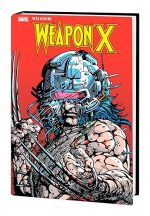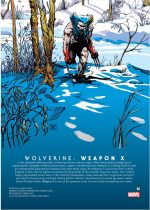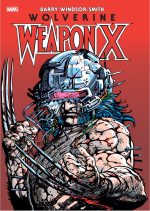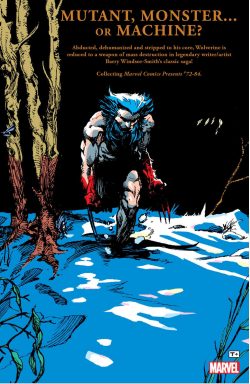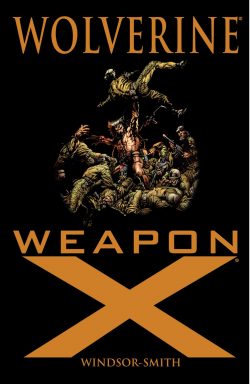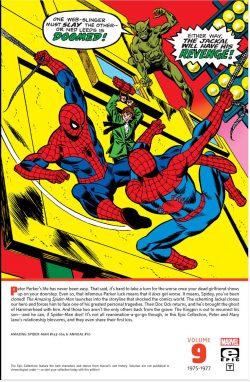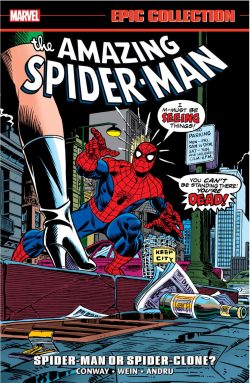

By Joe Kelly, Ed McGuiness, Larry Hama, Christopher Golden, Jeph Loeb, Adam Pollina, Aaron Lopresti, Bernard Chang, Ben Herrera, Adam Kubert, Fabio Laguna, Kevin Lau, Pete Woods, Shannon Denton & John Fang & various (MARVEL)
ISBN: 978-1-84653-427-0 (TPB/Digital edition)
With a long, LONG awaited cinematic combo clash finally headed our way this summer and in the year a certain Canadian Canucklehead’s turns 50, expect a few cashing-in style commendations and reviews. Here’s a handy starter package to set the ball rolling…
Bloodthirsty and stylish killers and mercenaries have long made for popular protagonists: so much so they even have their own movie subgenre. Deadpool is Wade Wilson (a barely disguised knockoff of Slade Wilson/Deathstroke the Terminator: get over it – DC did): a hired killer and survivor of genetics experiments that has left him a scarred, grotesque bundle of scabs and physical unpleasantries but practically invulnerable and capable of regenerating from any wound.
The wisecracking high-tech “merc with a mouth” was created by Rob Liefeld & Fabian Nicieza, debuting in New Mutants #97, and apparently another product of the US/Canadian Weapon X project that had created Wolverine and so many other mutant and/or cyborg super-doers. He got his first shot at solo stardom with a couple of miniseries in 1993 (see previous volume) but it wasn’t until 1997 that he finally won his own title.
This collection spans cover-dates December 1994 – October 1997, compiling the increasingly funny, furiously fight-filled Deadpool #1-9 (plus issue minus 1) as well as Wolverine #88, X-Force #47 & 56 and combination release Daredevil & Deadpool Annual 1997, with excerpted material from Wolverine Annual ‘95: all-in-all a frenetic blend of light-hearted, surreal, frays, frolics and incisive, poignant relationship drama that is absolutely compulsive reading for dyed-in-the-wool superhero fans who might be feeling just a little jaded with four-colour overload. For the sake of completeness, also included are pertinent snippets from X-Force #46, 71, 73 & 76…
Preceded by an Introduction from Joe Kelly, the cartoon violence kicks off with the First Official MU Meeting of its most stabby stalwarts. ‘It’s D-D-Deadpool, Folks!’ (by Larry Hama, Adam Kubert, Fabio Laguna & Mark Farmer) was December 1994’s Wolverine #88 wherein Wade is hunting his former girlfriend Vanessa AKA Copycat. Sadly, he’s looking in the same apartment severely-wounded X-Man Logan is searching for traces of equally missing cyborg (and Alpha Flight ally) Garrison Kane who was at that time calling himself “Weapon X”. In minted Marvel Manner, the misunderstanding leads to major violence and mass healing factor deployment…

The fractious relationship was renewed in a short from Wolverine Annual ’95 wherein Chris Golden, Ben Herrera &Vince Russell reveal ‘What the Cat Dragged In’ when Wolverine -seeking a cure for dying comrade Maverick (infected with the Legacy Virus) – accidentally liberates Wilson from a bio-lab where evil Dr. Westergaard and Slayback hold him captive. The villains wants to duplicate healing factors and soon pay heavily for their lack of ethics…
A slice of X-Force #46 and full load from #47#s ‘Breakout’ (September & October 1995 by Jeph Loeb, Adam Pollina & Mark Pennington) focuses on Deadpool’s ill-advised relationship with X-teen Siryn (Theresa Maeve Rourke Cassidy) who against her better judgement calls on the smitten merc to free her from an extremely unsafe asylum: The Weissman Institute. That bloody rescue only confirms that it’s not only the lunatics in charge of this nuthatch and in the melee mutant forces clash and Wade takes up involuntary residence…
He’s stuck there for a very long time and only let loose in ‘Crazy for You’ (X-Force #56, July 1996, by Loeb, Pollina, Bud LaRosa & Mark Morales) when mind-wiped Theresa regains lost memories and goes back to get him with teammate Shatterstar in tow. Once the true mastermind is exposed everyone makes for the exits in advance of the next big change…
Preceded by a mini-gallery of Ed McGuinness covers, at last, inevitably Deadpool claimed his own title. A new era began with extra-sized spectacular ‘Hey, It’s Deadpool!’ as Joe Kelly, McGuiness, Nathan Massengill & Norman Lee re-introduced the mouthy maniac, his “office” and “co-workers” at the Hellhouse where he picked up his contracts and also afforded us a glimpse at his private life in San Francisco. Here he has a house and keeps an old, blind lady a permanent hostage. This was never going to be your average superhero title but the creators fully leaned into the outrageous…
The insane action part of the tale comes from the South Pole where the Canadian government has a super-secret gamma weapon project going: guarded by Alpha Flight strongman Sasquatch. Now somebody is paying good money to have it destroyed, but nothing goes quite to plan…
In #2 ‘Operation: Rescue Weasel or That Wacky Doctor’s Game!’ finds the slightly gamma-irradiated hitman still mooning over lost love Siryn (I cannot emphasise this enough: the barely legal mutant hottie from X-Force) when his only friend/tech support guy Weasel goes missing, snatched by ninjas working for super-villain Taskmaster – and just when Deadpool’s healing ability is on the fritz. Deadpool #3’s ‘Stumped! Or This Little Piggie Went… Hey! Where’s the Piggy?!’ ramps up the screwball comedy quotient as Siryn convinces the merciless merc to turn his life around, which he’ll try just as soon as he tortures and slowly kills the doctor who first experimented on him all those years ago…
The turnabout storyline continues in ‘Why Is It, to Save Me, I Must Kill You?’ featuring a hysterically harrowing segment where Wilson must get a blood sample from The Incredible Hulk, before concluding in #5’s ‘The Doctor is Skinned!’ …or The End of Our First Story Arc’, wherein T-Ray – his biggest rival at Hellhouse – moves to become the company “top gun”…
Another extended story arc opens with Deadpool #6 and ‘Man, Check Out the Head on that Chick!’ as the gun (sword, grenade, knife, garrotte, spoon…) for hire accepts a contract to spring a woman from a mental asylum. Of course it’s never cut-and-dried in Wade’s World, and said patient is guarded by distressingly peculiar villainess The Vamp (who old-timers will recall changes into a giant, hairy naked telepathic cave-MAN when provoked …cue poor taste jokes by the dozen…).
The saga is briefly paused for a looming publishing event. Flashback was a company-wide publishing event wherein Marvel Stars shared an untold tale from their past, with each issue that month being numbered # -1. Deadpool’s contribution was a darker than usual tale from Kelly, Aaron Lopresti & Rachel Dodson, focusing on para-dimensional expediter Zoe Culloden. She’s a behind the scenes manipulator who has been tweaking Wilson’s life for years. ‘Paradigm Lost’ looks at formative moments from the hitman’s history and possibly reveals the moment when – if ever – the manic murderer started to become a better man…
Back at the plot (and with extra inking support from Chris Lichtner), it just gets worse in ‘Typhoid… It Ain’t Just Fer Cattle Any More or Head Trips’ as that captive chick turns out to be murderous multiple personality psycho-killer Typhoid Mary. Her seductive mind-tricks ensnare Deadpool, dragging him into conflict against the Man Without Fear in a closing episode mad-housed in Daredevil & Deadpool Annual 1997’s ‘Whomsoever Fights Monsters…’
Sadly, Typhoid isn’t easy to get rid of and Deadpool #8 (Kelly, Pete Woods, McGuiness, Shannon Denton, John Fang, Massengill & Lee) sees her still making things difficult for Wade in ‘We Don’t Need another Hero…’ with the merc forced to confront true madness… or is that True Evil?
It’s a return to lighter, but certainly no less traumatic, fare for final complete entry ‘Ssshhhhhhhhhh! or Heroes Reburned’ (with ancillary pencils by Denton) as Deadpool reclaims his pre-eminent position at Hellhouse just in time to be suckered into a psychological ambush by utterly koo-koo villain Deathtrap – clearly another huge fan of Tex Avery and Chuck Jones’ greatest hits…
Wrapping up the storytelling portion are pertinent moments from X-Force #71, 73 & 76, as crafted by John Francis Moore, Pollina, Andy Smith, Mike S. Miller, Morales, Mark Prudeaux, Rich Perrota, Walden Wong, Scott Hanna & Sean Parsons. Here dangling plot threads are addressed as Wade makes his peace with Siryn (or thinks he does) and fellow merc Domino hires out to insane assassin Arcade… with big trouble brewing for a later date…
Slowing the pace and closing this particular red ledger is a flurry of bonus features beginning with ‘Deadpool Behind the Scenes’ by Matt Idelson & Chris Carroll: outlining the creative process via ‘The Story’, ‘The Cover’, ‘If at First You Don’t Succeed…’
Next are ‘Character Design’, excerpted letters pages ‘Deadlines’; ‘Behind the Scenes: Daredevil/Deadpool ‘97’ and Behind the Scenes: Deadpool #6, 7 & 9’ from concept to finished art, and closing with articles and poster art from promo magazine Marvel Visions #12, plus house ads, trading card art (18 images by 21 different artists), even more posters and covers to earlier collected graphic novels.
Although staying close to the X-franchise that spawned him, Deadpool was always a welcome counterpoint to the constant sturm und drang of his Marvel contemporaries: weird, wise-cracking, and profoundly absurd on a satisfyingly satirical level. Now he’s bigger than God – Graeco-Roman ones at least – this titanic tome could serve as a great reintroduction to comics for fans who thought they had outgrown the fights ‘n’ tights crowd and a must have bible for film fans looking to get their funnybook freak on.
© 2022 MARVEL.


















